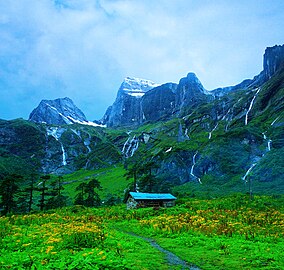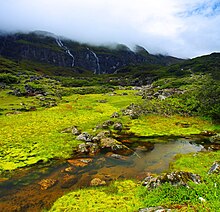Makalu Barun National Park: Difference between revisions
BhagyaMani (talk | contribs) Climate: climatic zone |
BhagyaMani (talk | contribs) →Climate: described temperature |
||
| Line 34: | Line 34: | ||
==Climate== |
==Climate== |
||
The park is located in the eastern climatic zone of the Himalayas, where [[monsoon]] already starts in June and eases off in late September. During these months about 70% of the annual precipitation of 4.000 mm falls. The first |
The park is located in the eastern climatic zone of the Himalayas, where [[monsoon]] already starts in June and eases off in late September. During these months about 70% of the annual precipitation of 4.000 mm falls. The first monsoon clouds reach the area already in April.<br /> |
||
Temperatures vary greatly due to the extreme difference in altitude in the entire area. Lower elevations are temperate throughout winter and hot during April and May. |
|||
==References== |
==References== |
||
Revision as of 16:55, 21 February 2010
| Makalu-Barun National Park and Conservation Area | |
|---|---|
 Landscape in Makalu-Barun National Park | |
| Location | Nepal |
| Area | 2330 km² |
| Established | 1992 |
Makalu-Barun National Park is the sixth national park in the Himalayas of Nepal and was established in 1992 as eastern extension of the Sagarmatha National Park. Covering an area of 1500 km2 in the districts of Solukhumbu and Sankhuwasabha it is the world’s only protected area with an elevation gain of more than 8.000 m enclosing tropical forest as well as snow-capped peaks.
The northern border of the national park coincides with the international border to the Tibet Autonomous Region. Adjacent to the southern and southeastern border is the bufferzone Makalu Barun Conservation Area covering an area of 830 km2.
The rugged summits of Makalu, with 8.463 m the fifth highest mountain of the world, Chamalang (7.319 m), Baruntse (7.129 m) and Mera (6.654 m) are included in the national park. The protected area extends to about 66 km from west to east and to about 45 km from north to south. From the Arun river valley in the southeast, located at 344-377 m above sea level, elevation gains about 8.025 m to the peak of Makalu. [1]
History

The idea of preserving the unique biological and cultural features of the Makalu-Barun area was already conceived in the mid-1980s. The management plans accomplished in 1990 also addressed the issue of protecting the upper watershed of the Arun River. In 1991 Makalu-Barun National Park was gazetted. When in 1999 the bufferzone was declared, the park was the first to include an adjacent inhabited conservation area. About 35,000 people reside in 12 Village Development Committees, who are primarily subsistence farmers of Sherpa, Rai, Gurung, Tamang, Magar, Newar, Brahmin and Chhetri ethnic groups. [2]
Both national park and conservation area are administered by the Department of National Parks and Wildlife Conservation. An innovative park management approach encourages local people to become actively involved in conserving their rich cultural heritage and protecting forests and natural resources, upon which their lives depend.
The inaccessible valleys of the Barun River, glacier-fed tributary to the Arun River, and of its tributary Saldima, treasure some of the last remaining pristine forests and alpine meadows. They have been designated as a Strict Nature Reserve, the first in Nepal, in order to protect natural ecosystems and processes in an undisturbed state for scientific study, environmental monitoring, education and the maintenance of genetic resources.
Climate
The park is located in the eastern climatic zone of the Himalayas, where monsoon already starts in June and eases off in late September. During these months about 70% of the annual precipitation of 4.000 mm falls. The first monsoon clouds reach the area already in April.
Temperatures vary greatly due to the extreme difference in altitude in the entire area. Lower elevations are temperate throughout winter and hot during April and May.
References
- ^ Carpenter, C., Zomer, R. (1996) Forest ecology of the Makalu-Barun National Park and Conservation Area, Nepal. Mountain Research and Development, 16 (2), 1996: 135-148
- ^ Mehta, J., Kellert, S. (1998) Local attitudes toward community-based conservation policy and programmes in Nepal: a case study in the Makalu-Barun Conservation Area. Environmental Conservation 25 (4): 320–333.
External links
